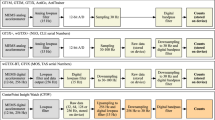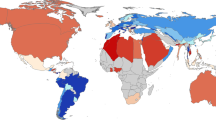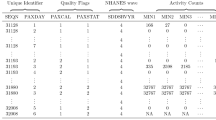Abstract
Wearable accelerometers provide detailed, objective, and continuous measurements of physical activity (PA). Recent advances in technology and the decreasing cost of wearable devices led to an explosion in the popularity of wearable technology in health research. An ever-increasing number of studies collect high-throughput, sub-second level raw acceleration data. In this paper, we discuss problems related to the collection and analysis of raw accelerometry data and refer to published solutions. In particular, we describe the size and complexity of the data, the within- and between-subject variability, and the effects of sensor location on the body. We also discuss challenges related to sampling frequency, device calibration, data labeling, and multiple PA monitors synchronization. We illustrate these points using the Developmental Epidemiological Cohort Study (DECOS), which collected raw accelerometry data on individuals both in a controlled and the free-living environment.









Similar content being viewed by others
References
Varma VR, Dey D, Leroux A, Di J, Urbanek J, Xiao L, Zipunnikov V (2017) Re-evaluating the effect of age on physical activity over the lifespan. Prev Med. https://doi.org/10.1016/j.ypmed.2017.05.030
Urbanek JK, Spira AP, Di J, Leroux A, Crainiceanu C, Zipunnikov V (2018a) Epidemiology of objectively measured bedtime and chronotype in US adolescents and adults: NHANES 2003–2006. Chronobiol Int https://doi.org/10.1080/07420528.2017.1411359
Schrack JA, Zipunnikov V, Goldsmith J, Bai J, Simonsick EM, Crainiceanu C, Ferrucci L (2014) Assessing the physical cliff: detailed quantification of age-related differences in daily patterns of physical activity. J Gerontol 69(8):973–979. https://doi.org/10.1093/gerona/glt199
Xiao L, Huang L, Schrack JA, Ferrucci L, Zipunnikov V, Crainiceanu CM (2015) Quantifying the lifetime circadian rhythm of physical activity: a covariate-dependent functional approach. Biostatistics 16(2):352–367. https://doi.org/10.1093/biostatistics/kxu045
Cook DJ, Thompson JE, Prinsen SK, Dearani JA, Deschamps C (2013) Functional recovery in the elderly after major surgery: assessment of mobility recovery using wireless technology. Ann Thorac Surg. https://doi.org/10.1016/j.athoracsur.2013.05.092
Fitzsimons CF, Kirk A, Baker G, Michie F, Kane C, Mutrie N (2013) Using an individualised consultation and activPAL\(^{{\rm TM}}\) feedback to reduce sedentary time in older Scottish adults: results of a feasibility and pilot study. Prev Med. https://doi.org/10.1016/j.ypmed.2013.07.017
Gresham G, Schrack J, Gresham LM, Shinde AM, Hendifar AE, Tuli R, Rimel BJ, Figlin R, Meinert CL, Piantadosi S (2018) Wearable activity monitors in oncology trials: current use of an emerging technology. Contemporary Clinical Trials https://doi.org/10.1016/j.cct.2017.11.002
Urbanek JK, Zipunnikov V, Harris T, Fadel W, Glynn N, Koster A, Caserotti P, Crainiceanu C, Harezlak J (2018c) Prediction of sustained harmonic walking in the free-living environment using raw accelerometry data. Physiol Meas. https://doi.org/10.1088/1361-6579/aaa74d
Urbanek JK, Zipunnikov V, Harris T, Crainiceanu C, Harezlak J, Glynn NW (2018b) Validation of gait characteristics extracted from raw accelerometry during walking against measures of physical function, mobility, fatigability, and fitness. J Gerontol Ser A. https://doi.org/10.1093/gerona/glx174
Chen KY, Janz KF, Zhu W, Brychta RJ (2012) Redefining the roles of sensors in objective physical activity monitoring. Med Sci Sports Exerc. https://doi.org/10.1249/MSS.0b013e3182399bc8
Matthews CE, Chen KY, Freedson PS, Buchowski MS, Beech BM, Pate RR, Troiano RP (2008) Amount of time spent in sedentary behaviors in the United States, 2003–2004. Am J Epidemiol 167(7):875–881. https://doi.org/10.1093/aje/kwm390
Healy GN, Matthews CE, Dunstan DW, Winkler EAH, Owen N (2011) Sedentary time and cardio-metabolic biomarkers in US adults: NHANES 200306. Eur Heart J 32(5):590–597. https://doi.org/10.1093/eurheartj/ehq451
Varma VR, Dey D, Leroux A, Di J, Urbanek J, Xiao L, Zipunnikov V (2018) Total volume of physical activity: TAC, TLAC or TAC(\(\lambda \)). https://doi.org/10.1016/j.ypmed.2017.10.028
Troiano RP, Berrigan D, Dodd KW, Mâsse LC, Tilert T, Mcdowell M (2008) Physical activity in the United States measured by accelerometer. Med Sci Sports Exerc 40(1):181–188. https://doi.org/10.1249/mss.0b013e31815a51b3
Copeland JL, Esliger DW (2009) Accelerometer assessment of physical activity in active, healthy older adults. J Aging Phys Act. https://doi.org/10.1123/japa.17.1.17
Di J, Leroux A, Urbanek J, Varadhan R, Spira A, Schrack J, Zipunnikov V (2017) Patterns of sedentary and active time accumulation are associated with mortality in us adults: the NHANES study. bioRxiv https://doi.org/10.1101/182337
Wrobel J, Zipunnikov V, Schrack J, Goldsmith J (2018) Registration for exponential family functional data. Biometrics 0(ja). https://doi.org/10.1111/biom.12963
Shou H, Zipunnikov V, Crainiceanu CM, Greven S (2015) Structured functional principal component analysis. Biometrics. https://doi.org/10.1111/biom.12236
Xiao L, Li Y, Ruppert D (2013) Fast bivariate P -splines: the sandwich smoother. J R Stat Soc Ser B. https://doi.org/10.1111/rssb.12007
Trost SG, Rosenkranz RR, Dzewaltowski D (2008) Physical activity levels among children attending after-school programs. Med Sci Sports Exerc. https://doi.org/10.1249/MSS.0b013e318161eaa5
Doherty A, Jackson D, Hammerla N, Plötz T, Olivier P, Granat MH, White T, Van Hees VT, Trenell MI, Owen CG, Preece SJ, Gillions R, Sheard S, Peakman T, Brage S, Wareham NJ (2017) Large scale population assessment of physical activity using wrist worn accelerometers: the UK biobank study. PLoS ONE. https://doi.org/10.1371/journal.pone.0169649
Bai J, Di C, Xiao L, Evenson KR, LaCroix AZ, Crainiceanu CM, Buchner DM (2016) An activity index for raw accelerometry data and its comparison with other activity metrics. PLoS ONE. https://doi.org/10.1371/journal.pone.0160644
Pober DM, Staudenmayer J, Raphael C, Freedson PS (2006) Development of novel techniques to classify physical activity mode using accelerometers. Med Sci Sports Exerc 38(9):1626–1634. https://doi.org/10.1249/01.mss.0000227542.43669.45
Staudenmayer J, Pober D, Crouter S, Bassett D, Freedson P (2009) An artificial neural network to estimate physical activity energy expenditure and identify physical activity type from an accelerometer. J Appl Physiol 107(4):1300–1307. https://doi.org/10.1152/japplphysiol.00465.2009
Attal F, Mohammed S, Dedabrishvili M, Chamroukhi F, Oukhellou L, Amirat Y (2015) Physical human activity recognition using wearable sensors. Sensors (Basel) 15(12):31314–31338. https://doi.org/10.3390/s151229858
Bao L, Intille SS (2004) Activity recognition from user-annotated acceleration data pervasive computing. Pervasive Comput 3001:1–17. https://doi.org/10.1007/978-3-540-24646-6_1
Preece SJ, Goulermas JY, Kenney LPJ, Howard D, Meijer K, Crompton R (2009) Activity identification using body-mounted sensors—a review of classification techniques. Physiol Meas 30(4):R1–R33. https://doi.org/10.1088/0967-3334/30/4/R01
Bai J, Goldsmith J, Caffo B, Glass TA, Crainiceanu CM (2012) Movelets: a dictionary of movement. Electron J Stat 6:559–578. https://doi.org/10.1214/12-EJS684
He B, Bai J, Zipunnikov VV, Koster A, Caserotti P, Lange-Maia B, Glynn NW, Harris TB, Crainiceanu CM (2014) Predicting human movement with multiple accelerometers using movelets. Med Sci Sports Exerc 46(9):1859–1866. https://doi.org/10.1249/MSS.0000000000000285
Xiao L, He B, Koster A, Caserotti P, Lange-Maia B, Glynn NW, Harris TB, Crainiceanu CM (2016) Movement prediction using accelerometers in a human population. Biometrics 72(2):513–524. https://doi.org/10.1111/biom.12382
Trost SG, Mciver KL, Pate RR (2005) Conducting accelerometer-based activity assessments in field-based research. Med Sci Sports Exerc 37(11):531–543. https://doi.org/10.1249/01.mss.0000185657.86065.98
Schrack JA, Cooper R, Koster A, Shiroma EJ, Murabito JM, Rejeski WJ, Ferrucci L, Harris TB (2016) Assessing daily physical activity in older adults: unraveling the complexity of monitors, measures, and methods. J Gerontol Ser A. https://doi.org/10.1093/gerona/glw026
Song J, Swartz MD, Gabriel KP, Basen-Engquist K (2018) A semiparametric model for wearable sensor-based physical activity monitoring data with informative device wear. Biostatistics. https://doi.org/10.1093/biostatistics/kxx073
Staudenmayer J, Zhu W, Catellier DJ (2012) Statistical considerations in the analysis of accelerometry-based activity monitor data. Med Sci Sports Exerc 44(SUPPL. 1). https://doi.org/10.1249/MSS.0b013e3182399e0f
Troiano RP, McClain JJ, Brychta RJ, Chen KY (2014) Evolution of accelerometer methods for physical activity research. Br J Sports Med 48(13):1019–1023. https://doi.org/10.1136/bjsports-2014-093546
Matthews CE, Hagströmer M, Pober DM, Bowles HR (2012) Best practices for using physical activity monitors in population-based research. Med Sci Sports Exerc 44(SUPPL. 1):68–76. https://doi.org/10.1249/MSS.0b013e3182399e5b
Freedson P, Bowles HR, Troiano R, Haskell W (2012) Assessment of physical activity using wearable monitors: recommendations for monitor calibration and use in the field. Med Sci Sports Exerc 44(SUPPL. 1):S1–S4. https://doi.org/10.1249/MSS.0b013e3182399b7e
Troiano RP (2007) Large-scale applications of accelerometers: new frontiers and new questions. Med Sci Sports Exerc. https://doi.org/10.1097/mss.0b013e318150d42e
Choi L, Ward SC, Schnelle JF, Buchowski MS (2012) Assessment of wear/nonwear time classification algorithms for triaxial accelerometer. Med Sci Sports Exerc 44(10):2009–2016
Van Domelen DR (2018) Accelerometry: functions for processing accelerometer data. https://CRAN.R-project.org/package=accelerometry. r package version 3.1.2
Catellier DJ, Hannan PJ, Murray DM, Addy CL, Conway TL, Yang S, Rice JC (2005) Imputation of missing data when measuring physical activity by accelerometry. Med Sci Sports Exerc. https://doi.org/10.1249/01.mss.0000185651.59486.4e
Storti KL, Pettee KK, Brach JS, Talkowski JB, Richardson CR, Kriska AM (2008) Gait speed and step-count monitor accuracy in community-dwelling older adults. Med Sci Sports Exerc 40(1):59–64. https://doi.org/10.1249/mss.0b013e318158b504
Fortune E, Lugade V, Morrow M, Kaufman K (2014) Validity of using tri-axial accelerometers to measure human movement—part II: step counts at a wide range of gait velocities. Med Eng Phys 36(6):659–669. https://doi.org/10.1016/j.medengphy.2014.02.006
Fairclough SJ, Noonan R, Rowlands AV, van Hees V, Knowles Z, Boddy LM (2016) Wear compliance and activity in children wearing wrist- and hip-mounted accelerometers. Med Sci Sports Exerc 48(2):245–253. https://doi.org/10.1249/MSS.0000000000000771
Brønd JC, Arvidsson D (2016) Sampling frequency affects the processing of actigraph raw acceleration data to activity counts. J Appl Physiol 120(3):362–369. https://doi.org/10.1152/japplphysiol.00628.2015
Lange-Maia BS, Newman AB, Strotmeyer ES, Harris TB, Caserotti P, Glynn NW (2015) Performance on fast- and usual-paced 400-m walk tests in older adults: are they comparable? Aging Clin Exp Res 27(3):309–314. https://doi.org/10.1007/s40520-014-0287-y
van Hees VT, Gorzelniak L, Dean León EC, Eder M, Pias M, Taherian S, Ekelund U, Renström F, Franks PW, Horsch A, Brage S (2013) Separating movement and gravity components in an acceleration signal and implications for the assessment of human daily physical activity. PLoS ONE. https://doi.org/10.1371/journal.pone.0061691
van Hees VT, Fang Z, Langford J, Assah F, Mohammad A, da Silva ICM, Trenell MI, White T, Wareham NJ, Brage S (2014) Autocalibration of accelerometer data for free-living physical activity assessment using local gravity and temperature: an evaluation on four continents. J Appl Physiol 117(7):738–744. https://doi.org/10.1152/japplphysiol.00421.2014
Vähä-Ypyä H, Vasankari T, Husu P, Suni J, Sievänen H (2015) A universal, accurate intensity-based classification of different physical activities using raw data of accelerometer. Clin Physiol Funct Imaging 35(1):64–70. https://doi.org/10.1111/cpf.12127
Mariani B, Rouhani H, Crevoisier X, Aminian K (2013) Quantitative estimation of foot-flat and stance phase of gait using foot-worn inertial sensors. Gait Posture 37(2):229–234. https://doi.org/10.1016/j.gaitpost.2012.07.012
Bai J, He B, Shou H, Zipunnikov V, Glass TA, Crainiceanu CM (2014) Normalization and extraction of interpretable metrics from raw accelerometry data. Biostatistics 15(1):102–116. https://doi.org/10.1093/biostatistics/kxt029
Esliger DW, Copeland JL, Barnes JD, Tremblay MS (2005) Standardizing and optimizing the use of accelerometer data for free-living physical activity monitoring. J Phys Act Health 2(3):366–383. https://doi.org/10.1123/jpah.2.3.366
Cain KL (2014) Accelerometer scoring protocol for the ipen-adult study. http://www.ipenproject.org/documents/methods_docs/IPEN_Protocol.pdf. Accessed 19 Nov 2017
NHANES (2011) National Health and Nutrition Examination Survey. 2011-2012 physical activity monitor (PAM) procedures manual. Centers for disease control and prevention (CDC). National Center for Health Statistics (NCHS), Hyattsville, MD: U.S. Department of Health and Human Services, Centers for Disease Control and Prevention. https://wwwn.cdc.gov/nchs/data/nhanes/2011-2012/manuals/Physical_Activity_Monitor_Manual.pdf. Accessed 19 Nov 2017
NHANES (2006) National Health and Nutrition Examination Survey. 2003-2004 data documentation, codebook, and frequencies. Physical activity monitor. Centers for disease control and prevention (CDC). National Center for Health Statistics (NCHS), Hyattsville, MD: U.S. Department of Health and Human Services, Centers for Disease Control and Prevention. https://wwwn.cdc.gov/Nchs/Nhanes/2003-2004/PAXRAW_C.htm. Accessed 19 Nov 2017
NHANES (2008) National Health and Nutrition Examination Survey. 2005-2006 data documentation, codebook, and frequencies. Physical activity monitor. Centers for disease control and prevention (CDC). National Center for Health Statistics (NCHS), Hyattsville, MD: U.S. Department of Health and Human Services, Centers for Disease Control and Prevention. https://wwwn.cdc.gov/Nchs/Nhanes/2005-2006/PAXRAW_D.htm. Accessed 19 Nov 2017
Lyden K, Keadle SK, Staudenmayer J, Freedson PS (2014) A method to estimate free-living active and sedentary behavior from an accelerometer. Med Sci Sports Exerc 46(2):386–397. https://doi.org/10.1249/MSS.0b013e3182a42a2d
Urbanek JK, Vadim Zipunnikov TH, Fadel W, Glynn N, Koster A, Caserotti P, Crainiceanu C, Harezlak J (2015) Prediction of sustained harmonic walking in the free-living environment using raw accelerometry data. arXiv:1505.04066. Accessed 19 Nov 2017
Studenski S, Perera S, Patel K, Rosano C, Faulkner K, Inzitari M, Brach J, Chandler J, Cawthon P, Connor EB, Nevitt M, Visser M, Kritchevsky S, Badinelli S, Harris T, Newman AB, Cauley J, Ferrucci L, Guralnik J (2011) Gait speed and survival in older adults. JAMA 305(1):50–58. https://doi.org/10.1001/jama.2010.1923
IJmker T, Lamoth CJ (2012) Gait and cognition: the relationship between gait stability and variability with executive function in persons with and without dementia. Gait Posture 35(1):126–130. https://doi.org/10.1016/j.gaitpost.2011.08.022
Urbanek JK, Harezlak J, Glynn NW, Harris T, Crainiceanu C, Zipunnikov V (2017) Stride variability measures derived from wrist- and hip-worn accelerometers. Gait Posture 52:217–223. https://doi.org/10.1016/j.gaitpost.2016.11.045
Koster A, Shiroma EJ, Caserotti P, Matthews CE, Chen KY, Glynn NW, Harris TB (2016) Comparison of sedentary estimates between activPAL and Hip- and Wrist-Worn ActiGraph. Med Sci Sports Exerc 48(8):1514–1522. https://doi.org/10.1249/MSS.0000000000000924
Rosenberger ME, Haskell WL, Albinali F, Mota S, Nawyn J, Intille S (2013) Estimating activity and sedentary behavior from an accelerometer on the hip or wrist. https://doi.org/10.1249/MSS.0b013e31827f0d9c
Trost SG, Zheng Y, Wong WK (2014) Machine learning for activity recognition: hip versus wrist data. Physiol Meas 35(11):2183–2189. https://doi.org/10.1088/0967-3334/35/11/2183
Del Din S, Hickey A, Hurwitz N, Mathers JC, Rochester L, Godfrey A (2016) Measuring gait with an accelerometer-based wearable: influence of device location, testing protocol and age. Physiol Meas 37(10):1785–1797. https://doi.org/10.1088/0967-3334/37/10/1785
Boerema S, van Velsen L, Schaake L, Tönis T, Hermens H (2014) Optimal sensor placement for measuring physical activity with a 3D accelerometer. Sensors 14(2):3188–3206. https://doi.org/10.3390/s140203188
O’Neill B, McDonough SM, Wilson JJ, Bradbury I, Hayes K, Kirk A, Kent L, Cosgrove D, Bradley JM, Tully MA (2017) Comparing accelerometer, pedometer and a questionnaire for measuring physical activity in bronchiectasis: a validity and feasibility study. Respir Res 18(1):16. https://doi.org/10.1186/s12931-016-0497-2
Edwardson CL, Winkler EA, Bodicoat DH, Yates T, Davies MJ, Dunstan DW, Healy GN (2016) Considerations when using the activPAL monitor in field based research with adult populations. J Sport Health Sci. https://doi.org/10.1016/j.jshs.2016.02.002
Yurtman A, Barshan B (2017) Activity recognition invariant to sensor orientation with wearable motion sensors. Sensors (Switzerland). https://doi.org/10.3390/s17081838
Dominguez-Vega ZT, Martinez-Mendez R, Lorias-Espinoza D (2015) High sampling rate datalogger for the characterization of acceleration signals on the human body running. In: 25th international conference on electronics, communications and computers, CONIELECOMP 2015, pp 173–177. https://doi.org/10.1109/CONIELECOMP.2015.7086947
ActiGraph (2016) What are counts? https://actigraph.desk.com/customer/en/portal/articles/2515580-what-are-counts-. Accessed 23 Nov 2017
Bassett DR, Rowlands A, Trost SG (2012) Calibration and validation of wearable monitors. Med Sci Sports Exerc. https://doi.org/10.1249/MSS.0b013e3182399cf7
Mathworks (2016) MATLAB—Mathworks—MATLAB & Simulink. 26 Nov 2016
Bussmann J, Tulen J, van Herel E, Stam H (1998) Quantification of physical activities by means of ambulatory accelerometry: a validation study. Psychophysiology 35(5):488–496. https://doi.org/10.1017/S0048577298971153
Godfrey A, Del Din S, Barry G, Mathers JC, Rochester L (2015) Instrumenting gait with an accelerometer: a system and algorithm examination. Med Eng Phys 37(4):400–407. https://doi.org/10.1016/j.medengphy.2015.02.003
Ellis K, Kerr J, Godbole S, Staudenmayer J, Lanckriet G (2016) Hip and wrist accelerometer algorithms for free-living behavior classification. Med Sci Sports Exerc 48(5):933–940. https://doi.org/10.1249/MSS.0000000000000840
Hickey A, Del Din S, Rochester L, Godfrey A (2017) Detecting free-living steps and walking bouts: validating an algorithm for macro gait analysis. Physiol Meas 38(1):N1–N15. https://doi.org/10.1088/1361-6579/38/1/N1
Straczkiewicz M, Urbanek JK, Fadel WF, Crainiceanu CM, Harezlak J (2016) Automatic car driving detection using raw accelerometry data. Physiol Meas 37(10):1757–1769. https://doi.org/10.1088/0967-3334/37/10/1757
Chen JH, Waite L, Kurina LM, Ra Thisted, McClintock M, Lauderdale DS (2014) Insomnia symptoms and actigraph-estimated sleep characteristics in a nationally representative sample of older adults. J Gerontol Ser A 8:1–8. https://doi.org/10.1093/gerona/glu144
Boudebesse C, Geoffroy PA, Henry C, Germain A, Scott J, Lajnef M, Leboyer M, Bellivier F, Etain B (2015) Links between sleep and body mass index in bipolar disorders: an exploratory study. Eur Psychiatry 30(1):89–93. https://doi.org/10.1016/j.eurpsy.2014.04.006
Cleland I, Kikhia B, Nugent C, Boytsov A, Hallberg J, Synnes K, McClean S, Finlay D (2013) Optimal placement of accelerometers for the detection of everyday activities. Sensors (Basel, Switzerland) 13(7):9183–9200. https://doi.org/10.3390/s130709183
Altini M, Penders J, Vullers R, Amft O (2015) Estimating energy expenditure using body-worn accelerometers: a comparison of methods, sensors number and positioning. IEEE J Biomed Health Inf 19(1):219–226. https://doi.org/10.1109/JBHI.2014.2313039
Stallings W (2008) Operating systems: internals and design principles, 6th edn. Prentice Hall Press, Upper Saddle River
Bennett TR, Gans N, Jafari R (2015) Multi-sensor data-driven: synchronization using wearable sensors. In: Proceedings of the 2015 ACM International Symposium on Wearable Computers (ISWC ’15), pp 113–116. ACM, New York. https://doi.org/10.1145/2802083.2808393
GaitUp (2017) Products. https://www.gaitup.com/products/. Accessed 25 Nov 2017
Curone D, Bertolotti GM, Cristiani A, Secco EL, Magenes G (2010) A real-time and self-calibrating algorithm based on triaxial accelerometer signals for the detection of human posture and activity. IEEE Trans Inf Technol Biomed. https://doi.org/10.1109/TITB.2010.2050696
Acknowledgements
The authors would like to acknowledge Annemarie Koster, Ph.D. and Paolo Caserotti, Ph.D. for designing the DECOS experiments.
Funding
This research was supported by Pittsburgh Claude D. Pepper Older Americans Independence Center, Research Registry, and Developmental Pilot Grant (PI: Glynn)—NIH P30 AG024826 and NIH P30 AG024827; National Institute on Aging Professional Services Contract HHSN271201100605P; NIA Aging Training Grant (PI: AB Newman) T32-AG-000181. The project was supported, in part, by the Intramural Research Program of the National Institute on Aging.
Author information
Authors and Affiliations
Corresponding author
Appendix A
Appendix A
See Table 3.
Rights and permissions
About this article
Cite this article
Karas, M., Bai, J., Strączkiewicz, M. et al. Accelerometry Data in Health Research: Challenges and Opportunities. Stat Biosci 11, 210–237 (2019). https://doi.org/10.1007/s12561-018-9227-2
Received:
Revised:
Accepted:
Published:
Issue Date:
DOI: https://doi.org/10.1007/s12561-018-9227-2




